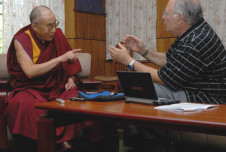“You people, I hate your guts!” And so began the school year with Stephen, a student in my 3rd/4th grade classroom whose frequent outbursts usually included more colorful and sometimes more threatening language.
It wasn’t until April that we finally managed to get Stephen the psychological help he had so badly needed for years. By that time, though, my nerves were frayed. Every night, I fretted about what more I could do to help Stephen, and I constantly beat myself up for not being able to establish a classroom where all students felt happy and safe.
Without realizing it, I was on the road to burnout.
 © Bobbieo
© Bobbieo
Teacher burnout is almost epidemic in this country and is one of the causes of the 17 percent annual attrition rate amongst educators. Scientists have found that teachers can burnout from the negative emotions and inefficacy they feel around the challenges of managing their students.
Thankfully, science has also found a positive way to deal with these emotions through something called self-compassion.
Kristin Neff, pioneering researcher and author of the book Self-Compassion, believes the practice can greatly benefit educators.
“With the burnout issues teachers face, taking care of themselves through work/life balance is important, but it isn’t enough,” says Neff, “Teachers need to give themselves permission to be self-compassionate for the stress they’re under.”
She describes the practice as a way of reining in our inner critic, replacing it with a voice of support, understanding and care.
The potential benefits of self-compassion are huge. Neff has found that people who practice self-compassion experience fewer negative emotions and stay emotionally balanced in difficult situations—both of which, according to a study on emotional exhaustion among teachers, help prevent teacher burnout.
Neff says that the first component of self-compassion is self-kindness, or treating ourselves with the same care we would give a loved one. As teachers, we care for our students every day but often forget about caring for ourselves.
To help, Neff suggests talking to yourself in the same supportive way you would your best friend. So the next time you come home from a rough day in the classroom (one of those that makes you wonder why you ever became a teacher in the first place), instead of berating yourself for every wrong thing you said to your students, try telling yourself something like this (or whatever might feel natural):
I’m so sorry you had a rough day. Even though you may have said some things to students you wish you hadn’t, it’s okay. All teachers do that once in awhile, but the students survive and so will you. I know you care so much about your students and want them to be successful. Teaching is one of the most challenging jobs out there, and you’re doing the best you can.
The second component of self-compassion is recognizing our common humanity. In other words, it’s helpful to remember that we’re all in this together and everyone has to deal with the challenges of life.
“When something bad happens, our normal reaction is ‘this should not be happening,’” says Neff. “The recognition that this is the experience of teaching, that this isn’t abnormal, helps soften some of that resistance.”
Neff suggests having forums where teachers can talk with each other and realize that everyone beats themselves up and feels they’re a failure sometimes. “Just knowing you’re not alone can be very freeing,” she says.
The third and final component of self-compassion is mindfulness, the moment-by-moment awareness of our thoughts and feelings. Research has suggested that teachers who practice mindfulness are less likely to experience negative emotions and depression and more likely to enjoy a positive state of mind.
 © Christopher Futcher
© Christopher Futcher
By practicing mindfulness during difficult times, Neff says we can “notice” our negative emotions without getting caught up in them, which then allows us to comfort ourselves with compassionate understanding.
Neff has created exercises to help people practice self-compassion in the quiet of their own home; however, she believes teachers can also benefit from knowing how to practice in the middle of a hectic day in the classroom.
“In the heat of the moment,” says Neff, “self-compassion gives you the calm and clarity you need to get through a tough situation emotionally and do your best—a win-win situation for both teachers and students.”
Here are two of Neff’s “in-the-moment” exercises for teachers:
1. Self-squeeze. Wrap your arms around yourself or fold your arms in a non-obvious way that mirrors a hug. Just as you would hug a friend who’s having a rough day, this physical gesture of self-compassion is an easy way to soothe and comfort yourself.
2. Breathe-in, breathe-out compassion. Based on a Buddhist meditation method, this practice can easily be done when faced with a challenging student or situation. Very simply, you breathe-in compassion for yourself and breathe-out compassion for the other.
Another benefit of practicing self-compassion in the classroom is the potential soothing effect on students. According to Neff, when we give ourselves compassion, our faces will subtly show it—and students can pick up on this change, helping to calm and soothe them as well.
Teaching will always be a hard job. But self-compassion is a great way for teachers to bounce back from challenging students, bad days, or lessons that fall flat—plus it feels good, says Neff.
“One of the most powerful things about compassion,“ she says, “is it makes you feel safe and calmer. Instead of just feeling empathy for your students—which is essentially feeling their pain—self-compassion allows you to embrace that pain with loving-kindness, which makes it bearable.”







Comments
Thank you for writing this… what a great article! As a new instructor, I hope to learn and incorporate these tips early on.
JSP | 8:48 am, September 18, 2012 | Link
This is a wonderful article, especially the “in-the-
moment exercises.” The information is just as
valuable for parents, I am looking forward to sharing
it with them. Thank you.
alison rogers | 9:38 am, September 18, 2012 | Link
Thank you both for your comments! I’m glad you
found the suggestions helpful.
Warmly,
vicki
Vicki Zakrzewski | 10:00 am, September 19, 2012 | Link